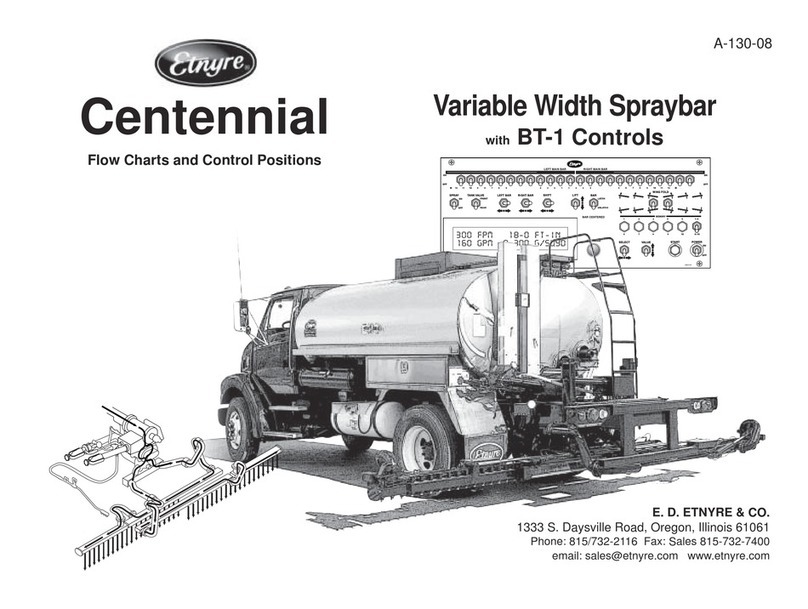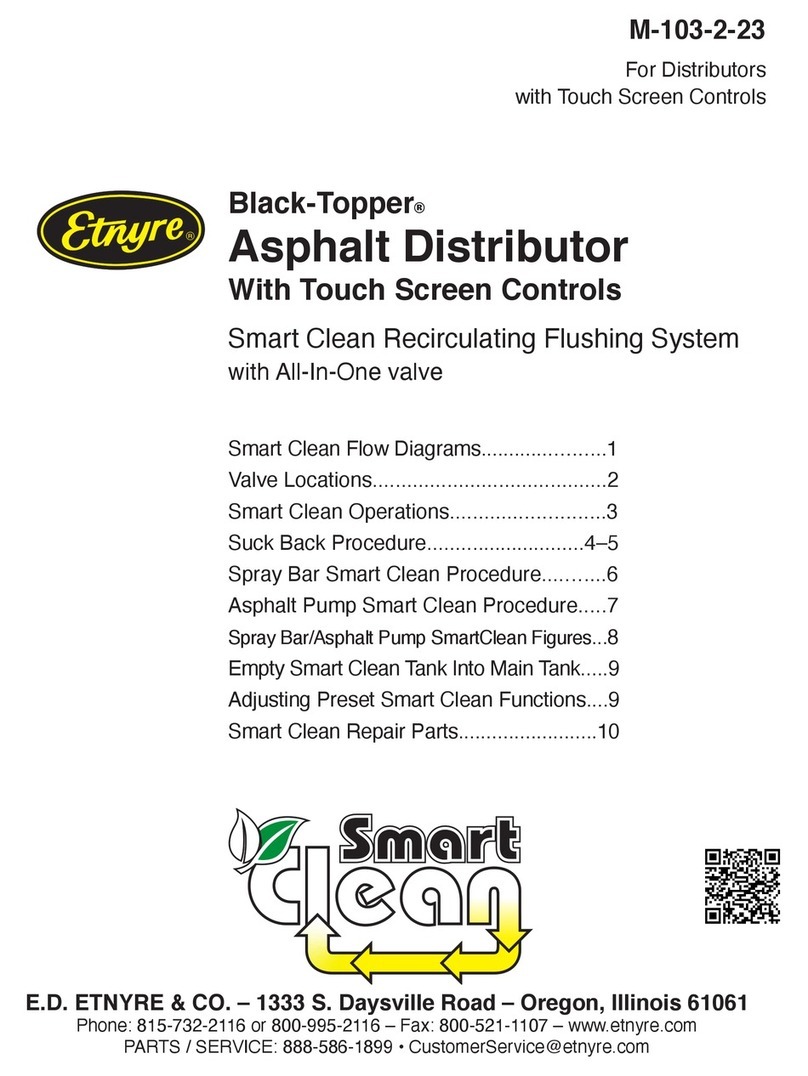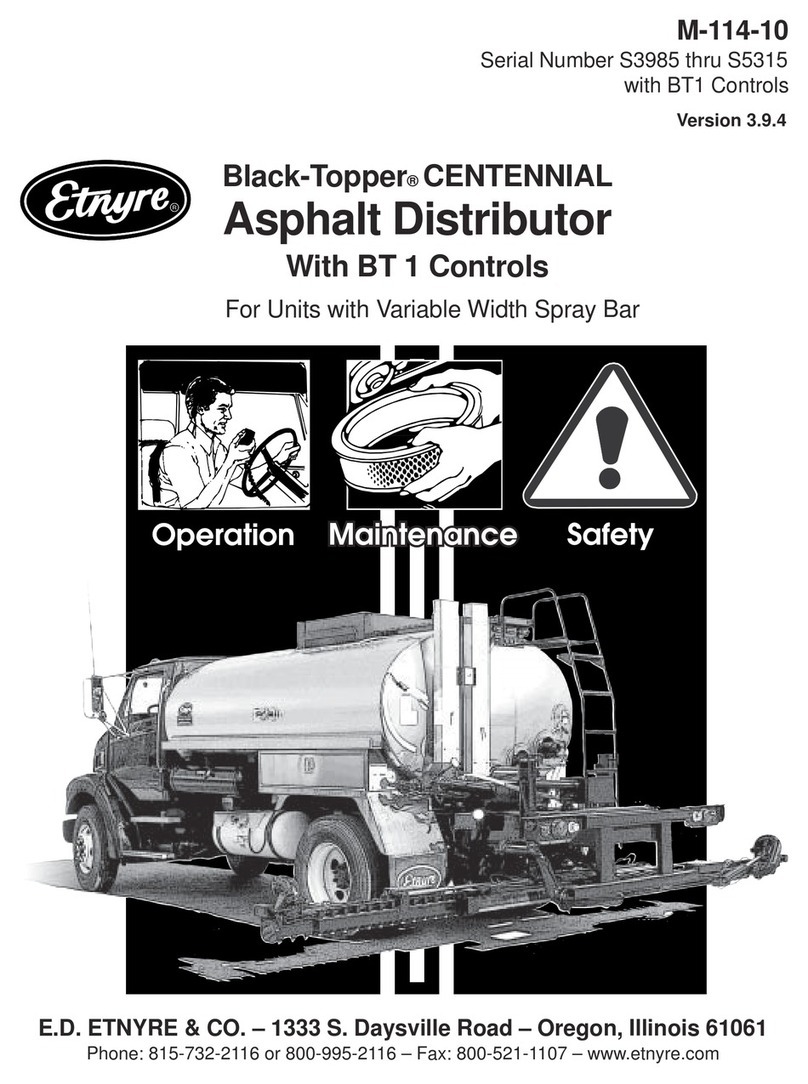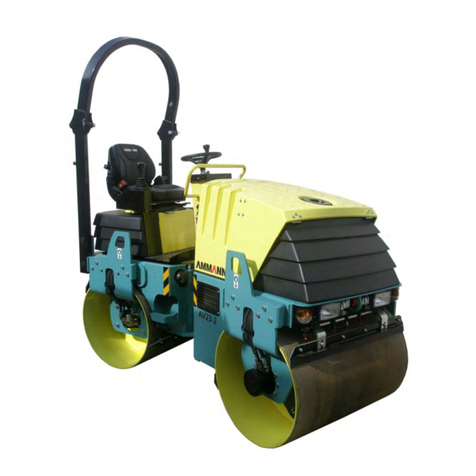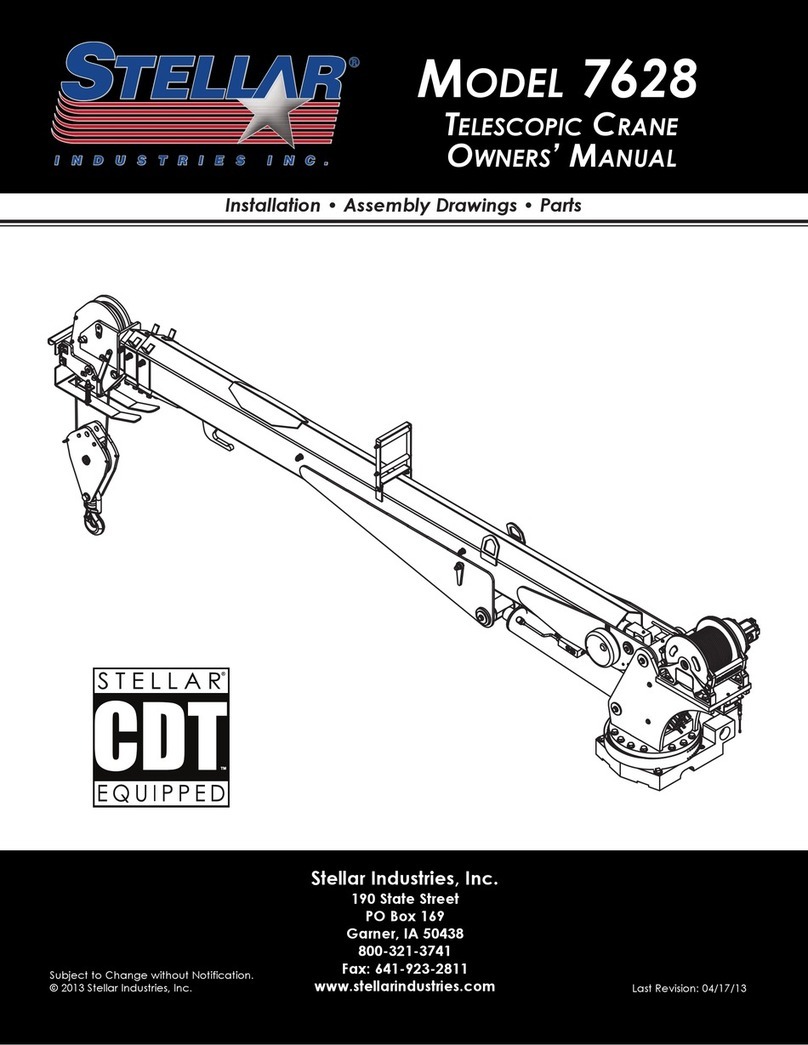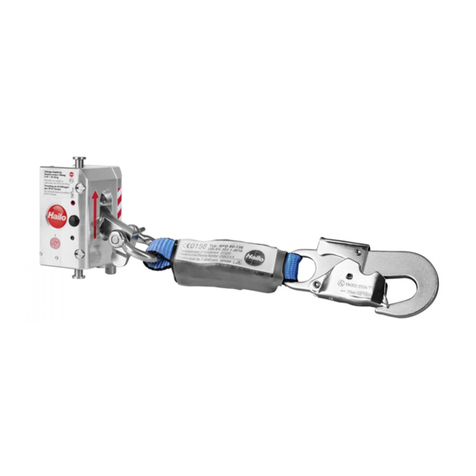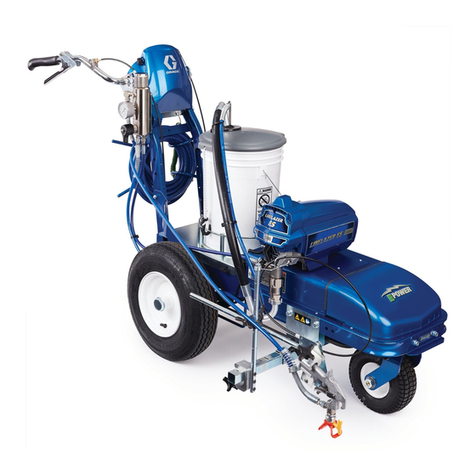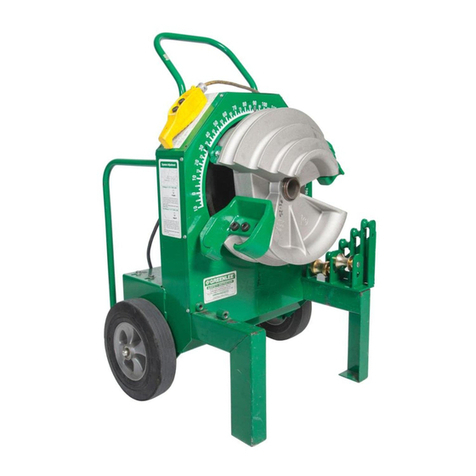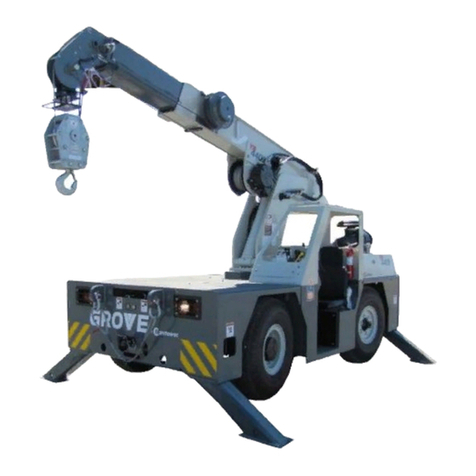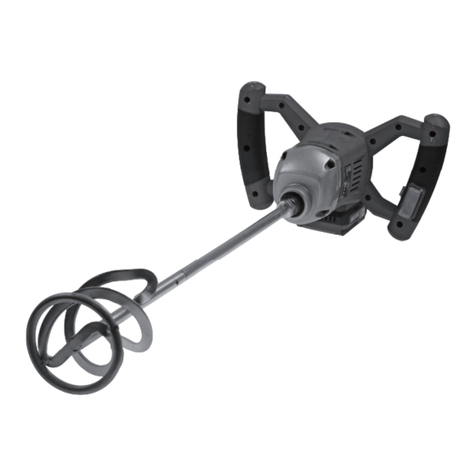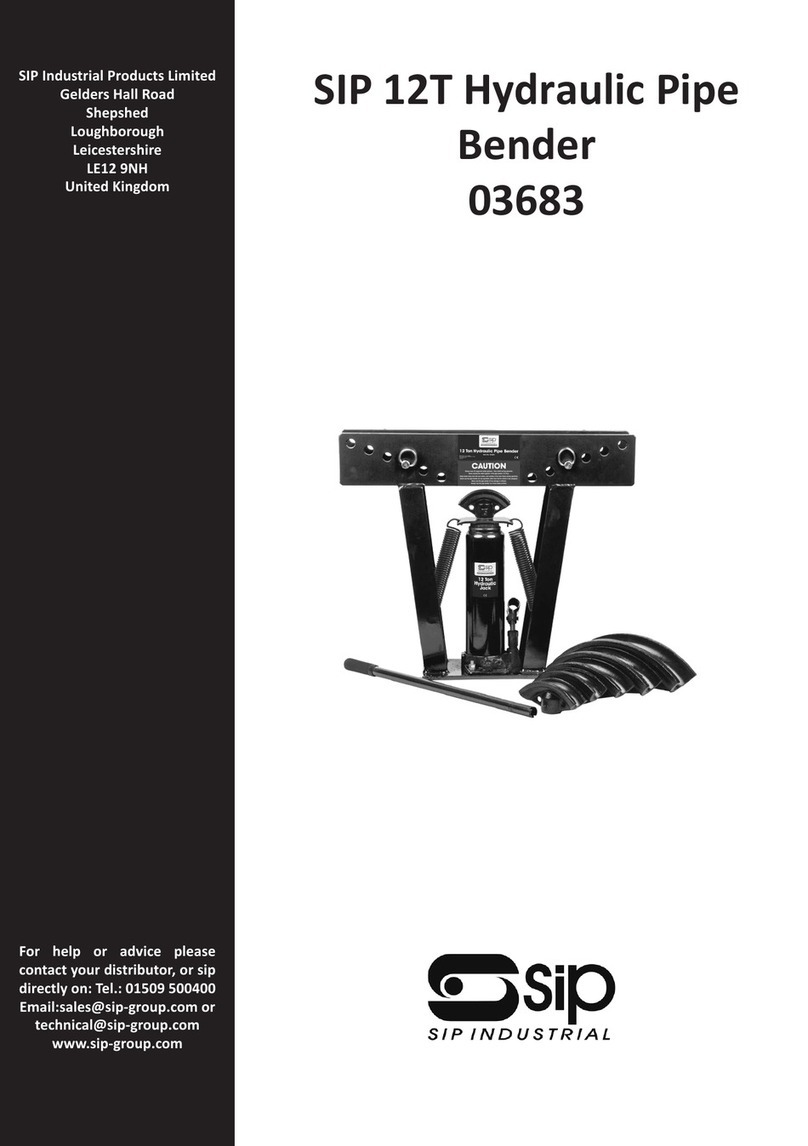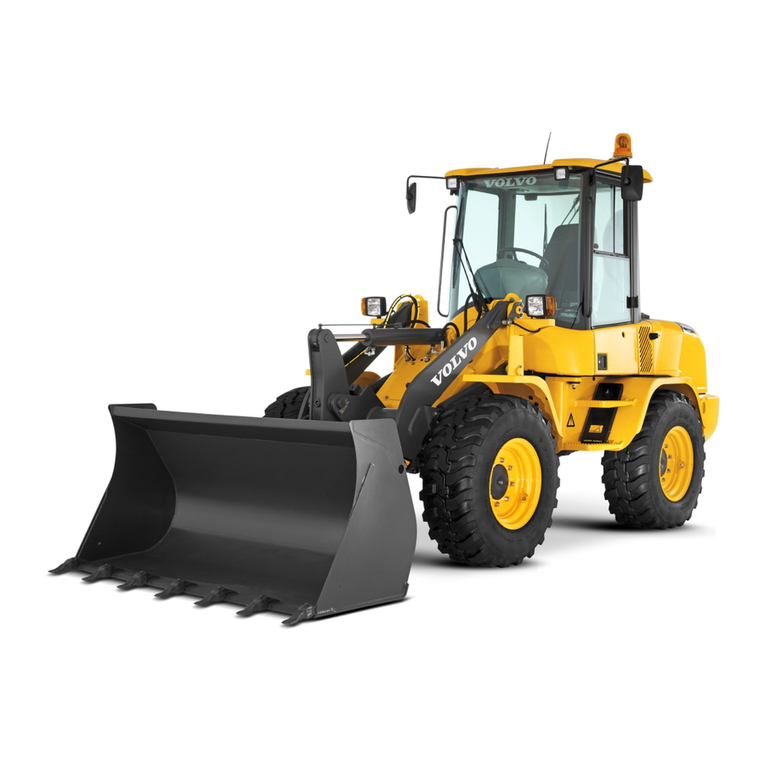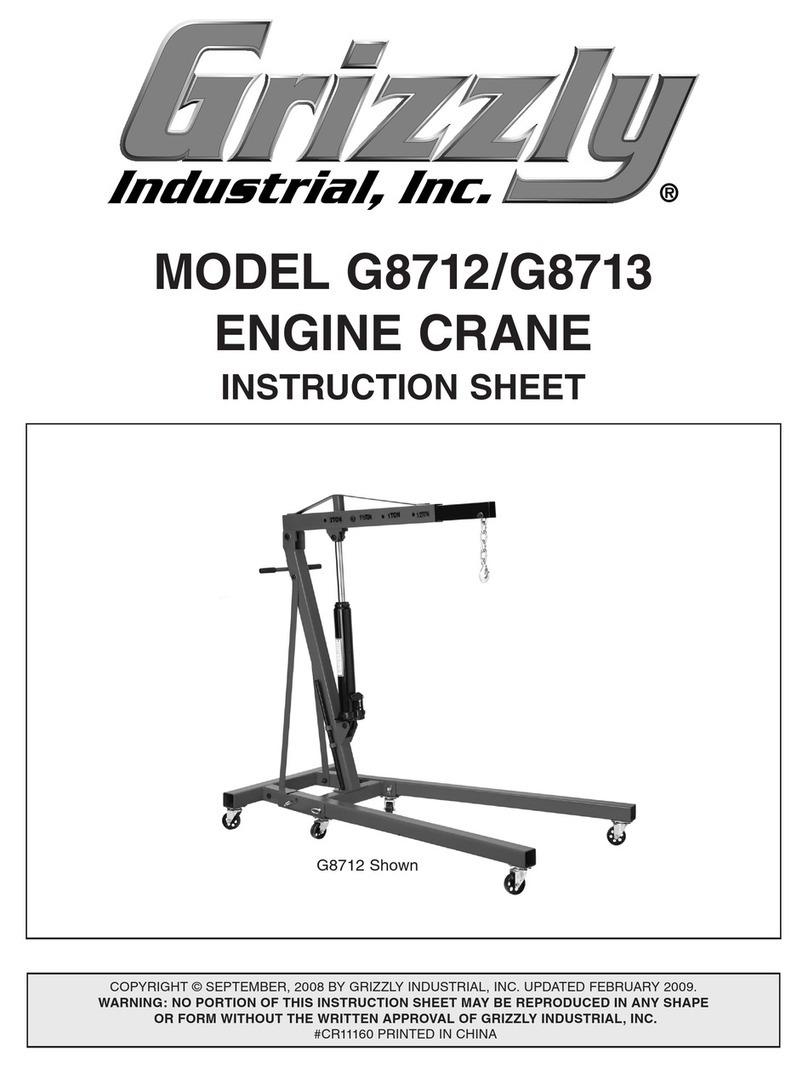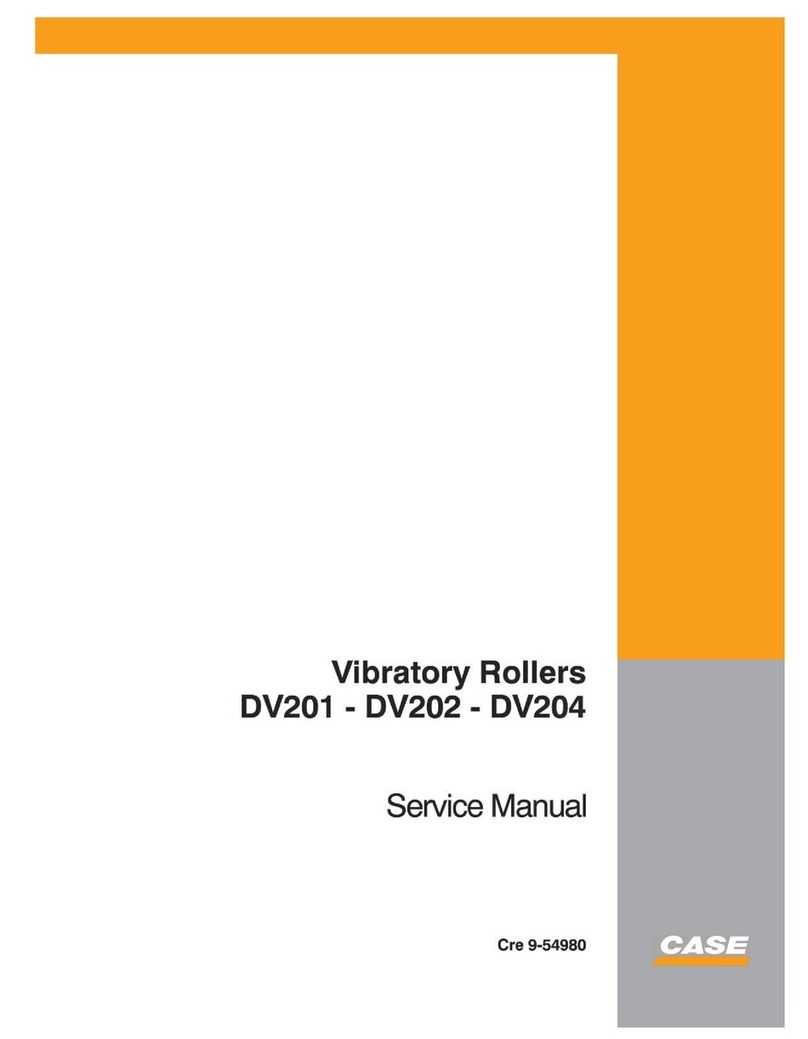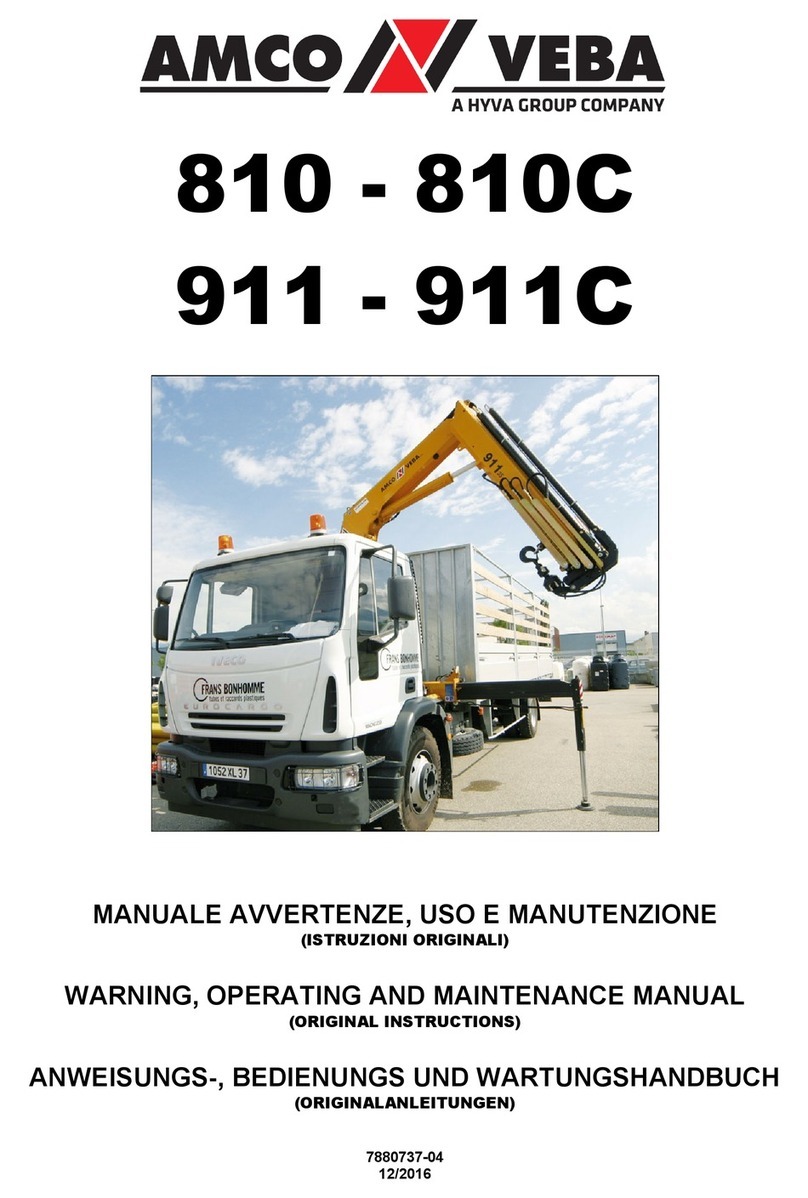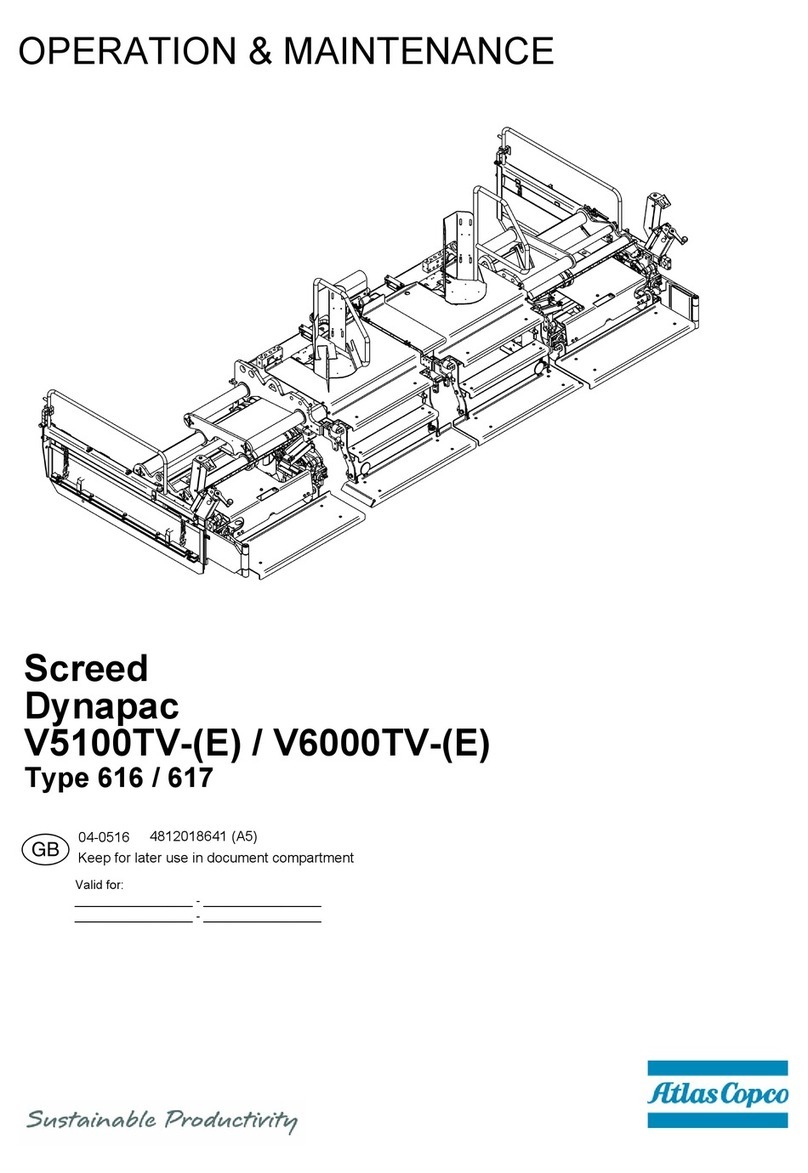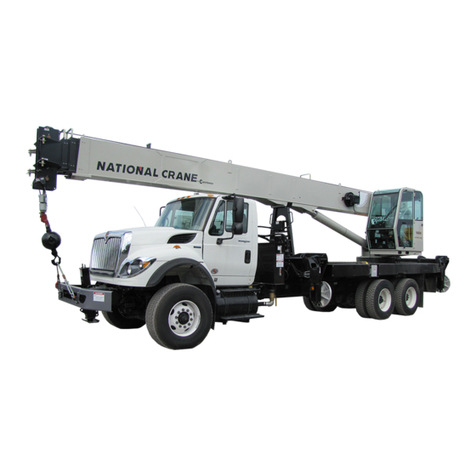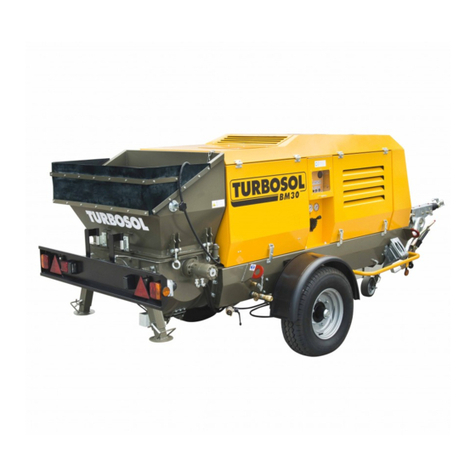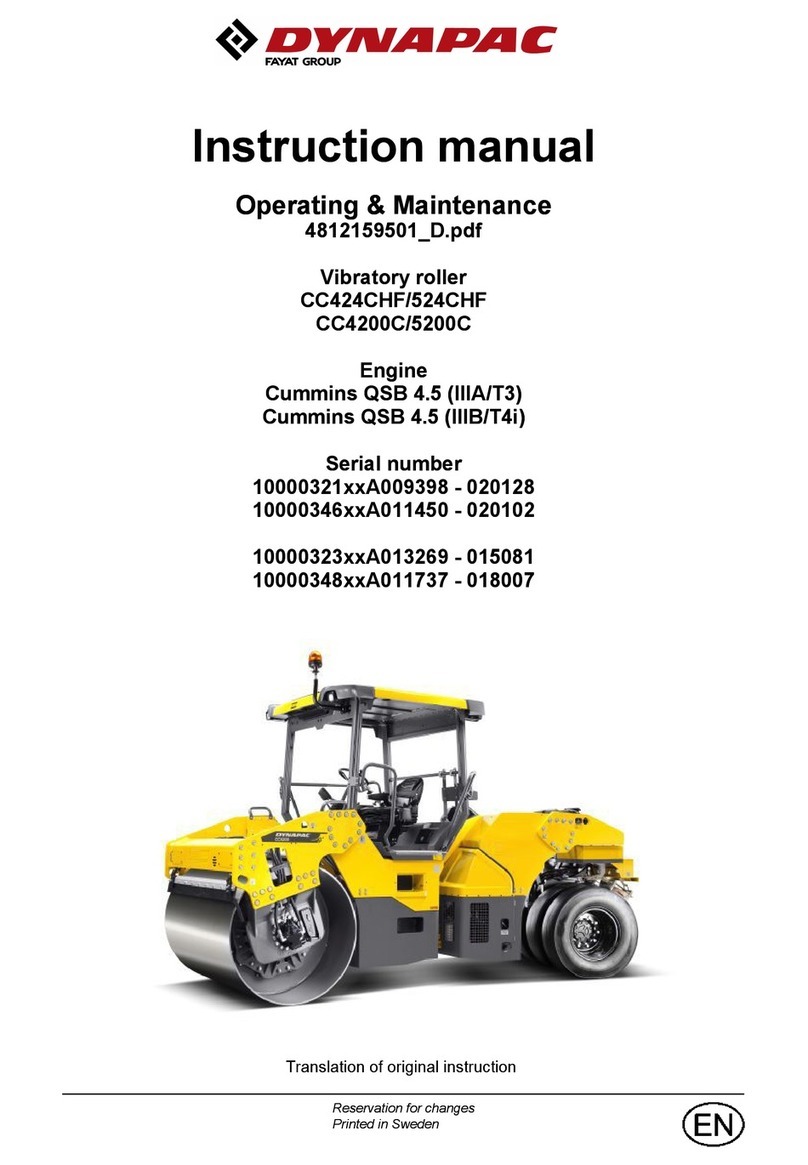Etnyre Black-Topper User guide


1
M-103-12R1
Black-Topper Centennial Operation, Maintenance, and Safety Manual
BLACK-TOPPER Distributor with
Standard Spraybar and BT-1 Controls
Version 4.5 & up
WARRANTY
E. D. Etnyre & Co. warrants to the original Purchaser, its new product to be free from defects in material and workmanship
for a period of twelve (12) months after date of delivery to original Purchaser. The obligation of the Company is limited
to repairing or replacing any defective part returned to the Company and will not be responsible for consequential
damages or any further loss by reason of such defect.
The company excludes all implied warranties of merchantability and tness for a particular purpose. There are no
warranties, express or implied, which extend beyond the description of the goods contained in this contract.
This warranty does not obligate the Company to bear the cost of machine transportation in connection with the
replacement or repair of defective parts, nor does it guarantee repair or replacement of any parts on which unauthorized
repairs or alterations have been made or for components not manufactured by the Company except to the extent of
the warranty given by the original Manufacturer.
This warranty does not apply to:
(1) Normal startup services, normal maintenance services or adjustments usually performed by the selling dealer,
factory service representative or customer personnel.
(2) Any product manufactured by E. D. Etnyre & Co. purchased or subjected to rental use.
(3) Any product or part thereof which shows improper operation, improper maintenance, abuse, neglect, damage or
modication after shipment from factory.
(4) Any product or part thereof damaged or lost in shipment. Inspection for damage should be made before acceptance
or signing any delivery documents releasing responsibility of the delivering carrier.
This warranty and foregoing obligations are in lieu of all other obligations and liabilities including negligence and all
warranties of merchantability or otherwise, express or implied in fact or by law.
WARNING
Do not use this machine for any operation that is
not described in this manual.
If you have any questions about operation of this
machine, contact the Etnyre Service Department at
1-800-995-2116 or 1-815-732-2116.
Operations that are not approved could cause
serious injury or death.
WARNING
Diesel engine exhaust and some of its constituents
are known to the State of California to cause
cancer, birth defects, and other reproductive harm.
Please note this warning
and remember:
• Always start and operate the engine in a well
ventilated area.
• If in an enclosed area, vent the exhaust to the
outside.
• Do not modify or tamper with the exhaust system.
Can cause serious injury or death.
Serial Number S5613 and up
Updated June 23, 2014

2
© Copyright 2010 E.D. Etnyre & Co.
All brand names, trademarks and registered
trademarks are the property of their respective
owners. Information contained within this
document is subject to change without notice. All
rights reserved.

3
Table of Contents
Safety Instructions
Warning And Instruction Plates ..........................5
General Safety Instructions ................................7
Safety Precautions, Hazard Seriousness Level .7
WARNINGS........................................................8
Fluoroelastomer Handling ...............................8
Foaming............................................................10
Asphalt Institute................................................10
Introduction.....................................................11
Reporting Safety Defects..................................11
Component Location And Identication............12
Rear and Side Components .............................12
Spray Bar Components ....................................13
Hydraulic Tank Components.............................13
Cab Control Panel ............................................14
Rear Control Panel...........................................16
Preparing for Operation.................................19
Setting Up the Computer..................................19
First Screen ..................................................19
Second Screen.............................................19
Third Screen .................................................19
Fourth Screen...............................................20
Fifth Screen ..................................................20
Sixth Screen .................................................20
Engaging Pump on PTO Equipped Distributors .. 20
Manual Transmissions..................................20
Automatic Transmissions..............................20
Spraying Operations.........................................21
Setting the Digital Memory Presets ..................22
Adjusting the Spray Bar Nozzle Angle..............22
Adjusting the Spray Bar Height ........................22
Operation.........................................................23
Tank Capacity...................................................23
Operation Screens............................................23
First Operating Screen .....................................23
Second Operating Screen ................................23
Third Operating Screen ....................................24
Information Messages ......................................24
Loading.............................................................26
Loading Through the Manhole......................26
Loading Through the Load Line
Connections and Preliminary Checks...........27
Check Strainers............................................27
Using the Measuring Stick............................27
Loading Through the Load Line....................28
Circulating in the Tank ......................................30
Circulating Product in the Bar...........................32
Spraying Through the Bar ................................34
Hand Spraying..................................................35
Spray Bar Suckback.........................................36
Bar Suck Back Override ...................................38
Handspray Suckback........................................39
Flushing Operations .........................................40
Bar Flush (Auto) ...........................................40
Bar Flush (Manual).......................................41
Enviro-Flush System (OPTIONAL)..............42
Recycle Enviro-Flush................................... 43
Unload Operations with External Pump............44
Unload Operations with Distributor Pump ........46
Transfer Operations..........................................48
Heating Product in Distributors ....................50
Heating with Propane Burners
.......................50
Propane Requirements................................50
Manual Ignition Control................................51
Ignition and Out Fire Control .......................52
Thermostatic Control ...................................54
Heating with Fuel Oil Burners
........................55
Ignition and Out Fire Control .......................56
Thermostatic Control ...................................57
Troubleshooting .............................................58
Maintenance....................................................60
Gun Assembly ..................................................60
Electrode Settings ............................................60
Check Ignition Transformer Spark....................61
Fire Burners......................................................61
Replacing Speed Pickup ..................................61
Servicing the Etnyre P-15 Pump ......................62
Vacuum Check .............................................62
Pump Disassembly And Inspection ..............62
Impeller Installation And Pump Assembly.....62
General Fuel Data and Heating Terminology ...63
Fuel Data......................................................63
Approximate Burner Fuel Consumption........63
Heating Terminology.....................................63
Hydraulic Fluid Requirements ..........................64
General Information......................................64
Hydraulic Fluid Requirements ......................64
Viscosity & Temperature Requirements .......64
Contamination Levels...................................65
Lubrication Chart ..............................................67
Etnyre Spraybar Nozzles..................................68
Serial Number Plate Location ..........................69
Decimal Equivalent Chart.................................69

4
List of Illustrations
Figure 1. Location of Warning and Instruction Plates..................................... 5
Figure 2. Rear and Side Component Identication....................................... 12
Figure 3. Rear Component Identication...................................................... 12
Figure 4 Spray Bar Component Identication.............................................. 13
Figure 5. Hydraulic Tank Component Identication. ..................................... 13
Figure 6. Cab Control Panel Components.................................................... 14
Figure 7. Rear Control Panel Components. ................................................. 16
Preparing for Operation
Figure 8. Adjusting the Spray Bar Nozzles. .................................................. 22
Figure 9. Adjusting the Spray Bar Height. .................................................... 22
Operation
Figure 11. Valve Positions for Loading Through the Manhole. ..................... 26
Figure 12. Using the Measuring Stick........................................................... 27
Figure 13. Valve Positions for Loading Through the Load Line.................... 28
Figure 14. Valve Positions for Circulating in the Tank. ................................. 30
Figure 15. Valve Positions for Circulating in the Bar..................................... 32
Figure 16. Valve Positions for Spraying Through the Bar............................. 34
Figure 17. Valve Positions for Handspray..................................................... 35
Figure 18. Valve Positions for Spray Bar Suck Back.................................... 36
Figure 19. Valve Postions for Flushing. ........................................................ 40
Figure 20. Enviro-Flush Flow Diagram........................................................ 42
Figure 21. Recirculating Flushing System Operation................................... 43
Figure 22. Valve Positions for Unload with External Pump. ......................... 44
Figure 23. Valve Positions for Unload with Distributor Pump. ...................... 46
Figure 24. Valve Positions for Transfer......................................................... 48
Figure 25. Manual Ignition Control. .............................................................. 51
Figure 26. Ignition and Out Fire Control. ...................................................... 52
Figure 27. Fuel Oil Burner System. .............................................................. 56
Maintenance
Figure 28. Gun Assembly. ............................................................................ 60
Figure 29. Right Hand / Left Hand Electrodes.............................................. 60
Figure 30. Electrode Setting......................................................................... 60
Figure 31. Hydraulic Motor. .......................................................................... 61
Figure 32. Etnyre Asphalt Pump................................................................... 62
Figure 33. Fluid Cleanliness Chart. .............................................................. 65
Figure 34. Serial Number Plate Location...................................................... 69

5
19 3390645 1 Label-Measuring Stick, 1 Flue
3390656 1 Label-Measuring Stick, 2 Flues
20 6320794 2 Plate- Warning, Manhole
21 6320790 1 Decal-Warning, GVWR
22 3390880 1 Decal-Handspray Operation
23 3390562 1 Bracket- Mtg, Decal, Hot Surface
24 6320800 1 Decal-Diesel Fuel Only
25 6320809 1 Decal-Instr, Air Oiler
26 6320785 2 Decal-Warn, 1" Handspray Hose
6320806 2 Decal-Warn, 3/4" Handspray Hose
27 6320802 1 Decal-Warning, Handspray Hose
28 6320784 1 Decal-Warning, Personal Protection
29 6320799 1 Plate- Warning, Burner, General
30 6320787 AR Decal- Directions, LPG Burner
31 6320804 1 Decal-Warning, No Riders
32 6320792 AR Decal- Directions, Fuel Oil Burners
*Included in 6320782 Decal Kit
•Included in 6320956 Decal Kit
starting with Serial# S5724
Warning And Instruction Plates
Figure 1. Location of Warning and Instruction Plates
For operator safety and possible liability protection, all Safety and Instruction Plates should
remain in place and be legible
Should a plate be removed, lost, or become illegible, reorder and replace immediately
If plates become difcult to read because of material coating the surface, clean with solvent
20
1
23
4
4
57
8
9
10
11
32
16 17 18
12
15
13
14
8
8
19
20 21
22
23
24 25
28
27
30
29
26
31
26
6
AR = As required
REF PART NO. QTY DESCRIPTION REF PART NO. QTY DESCRIPTION
1 6320808 1 Decal-Warn, Electrical Equipment
2 6320807 1 Decal-Warn, Master Power
3 6320796 1 Decal- Warning, Before Starting
4 6320793 2 Decal- Warning, Manuals
5 3390597 1 Plate-Name, Spec, VIN
6 3390696 2 Decal, Blacktopper Centennial
7 6320786 1 Plate-Instr, Hydraulic Oil
8 6320797 3 Plate-Caution, Hot Surface
9 3390655 1 Plate-Name, Distributor S/N, Brass
10 6320798 1 Decal-Warning, Safety, General
11 6320953 1 Decal-LP Burners
or
6320954 1 Decal-LP Burners w/ Outre
or
6320966 1 Decal-Fuel Oil Burners
12 6320272 AR Placard System (Optional)
13 6320789 1 Decal- Warning, Asphalt Grades
14 6320795 1 Decal- Warning, Fill Line Cap
15 6320788 1 Decal-Lubrication Chart
16 6320796 1 Decal- Warning, Before Starting
17 3390636 1 Decal- Warning, Flues Covered
18 9320955 1 Decal-Spray Valve Lubrication (VWSB)
•
•
•
•
•
•
•
•
•
•
•
•
•
•
•
•
•
•
•
•
•
•
•
•
*
•
*
*
*
*
*
*
*
*
*
*
*
*
*
*
*
*
*
*
*
*
*

6
NOTICE
The handling of Cationic Emulsions (CRS-2, CMS-2, CSS-1 and CSS) may
create an environment within the Asphalt Distributor that can be corrosive to
carbon steel and cast iron.
• Cationic Emulsions are widely used within the industry.
• Cationic Emulsion is manufactured with asphalt, water, emulsiers and
hydrochloric acid. The chemistry of individual emulsions varies in asphalt
content and Ph levels.
• Tanks and spray mechanisms used with Cationic emulsions may experience
corrosion
• It is believed the chemistry of the emulsion - specically the residual fumes
promote the corrosion
• Etnyre Distributors are compatible with Cationic Emulsions provided that
certain precautions are taken.
• Prior to placing a distributor in to service with Cationic Emulsion, it should be
loaded with an AC or MC type material to develop a protective coating.
• Periodic inspection of the tank and spray system should be preformed in the
normal course of operation.
• It is recommended that distributors used in Cationic service be ushed
periodically and at the end of the season with an AC, MC or cutback to
remove the corrosive materials and to provide a protective coating.
• Increasing the quantity of ushing material during daily suck back and
cleanout operations will also help to minimize corrosion damage.
• Dilution is the solution.
• Additional information can be acquired from your Emulsion supplier as well as
the Asphalt Institute or the Asphalt Emulsion Manufactures Association.
WARNING
Take extra care and follow recommended
procedures when alternating asphalt materials
especially when loading hot product, over 212
degrees Fahrenheit (100 degrees Celsius), on
to a tank and system previously in Emulsion
service.

7
The operation of a bituminous distributor normally requires handling of liquid products at elevated temperature.
Also, these liquids may be of a volatile nature. A heating system is supplied to raise or maintain the product
temperature, and these systems use highly combustible fuels. As with any type of construction equipment,
there are certain hazards associated with careless or improper operation.
Safety warnings have been provided to call attention to any potentially hazardous situation that may cause
property damage, personal injury or death to the operator or bystanders. These safety warnings will be shown
at various times throughout this manual, as they are applicable to the subject being presented. These safety
warnings are identied by the following warning symbols:
Safety Precautions, Hazard Seriousness Level
You will nd safety information boxes throughout this manual. These boxes contain information alerting you
to situations or actions to avoid.
Signal words (DANGER, WARNING, and CAUTION) are used to identify levels of hazard seriousness. Their
selection is based on the likely consequence of human interaction with a hazard. Denitions of hazard levels
are as follows.
DANGER - Immediate hazards which will result in severe personal injury or death.
WARNING - Hazards or unsafe practices which could result in severe personal injury or death.
CAUTION - Hazards or unsafe practices which could result in minor personal injury or product or
property damage.
All of these warnings are listed below and they also appear throughout the manual. In addition to these, you
will nd notes throughout the manual.
NOTE - A note provides general information that the operator should be aware of when performing an
operation.
General Safety Instructions
DANGER
To avoid an extreme re hazard or explosion,
NEVER use gasoline as fuel in diesel or fuel
oil burners.
WARNING
A fully charged dry chemical type re
extinguisher must be within easy reach
whenever the burners are operating or there
is an open ame near the Distributor. The
minimum capacity of the re extinguisher
should be 10 pounds.
Please Note This Warning
and Remember:
• Always start and operate the engine in a
well ventilated area.
• If in an enclosed area, vent the exhaust to
the outside.
• Do not modify or tamper with the exhaust
system.

8
WARNING
A fully charged dry chemical type re
extinguisher must be within easy reach
whenever the burners are operating or there
is an open ame near the Distributor. The
minimum capacity of the re extinguisher
should be 10 pounds.
Fluoroelastomer Handling
Some O-rings and seals used in this vehicle
are made from uoroelastomers, When used
under design conditions, uoroelastomers do
not require special handling. However, when
uoroelastomers are heated to temperatures
beyond their design temperature (around
600º Fahrenheit), decomposition may occur
with the formation of hydrouoric acid.
Hydrouoric acid can be extremely corrosive
to human tissue if not handled properly.
A degraded seal may appear as a charred
or black sticky mass, Do not touch either
the seal or the surrounding equipment
without wearing neoprene or PVC gloves if
degradation is suspected. Wash parts and
equipment with 10% lime water (calcium
hydroxide solution) to neutralize any
hydrouoric acid.
If contact with the skin occurs, wash the
affected areas immediately with water. Then
rub a 2.5 calcium gluconate gel into the skin
until there is no further irritation, while seeking
prompt medical attention.
Note to Physicians: For advice or treatment
of HF burns, call the DuPont Medical
Emergency number, 1-800-441-3637.
To prevent an explosion or re hazard:
• Position the unit broadside to the wind to
prevent volatile fumes from drifting toward
the burners.
• Do not operate the burners if the tank is
damaged or leaking.
• Ensure that the burners are extinguished
before removing any material from the
tank in any manner. Liquid petroleum (LP)
burners can support a ame for several
minutes after the fuel supply is turned off.
To prevent an explosion or re hazard:
• Do not operate the burners when the vehicle
is unattended, when the vehicle is in motion,
or with the vehicle in a conned area.
• When the burners go out, shut off the fuel
supply to both burners and allow the ues to
ventilate for at least 3 minutes before re-
lighting the burners.
• Do not heat the material beyond the
manufacturer’s recommended temperature.
• Keep burning cigarettes or other sources
of combustion away from manholes and
overow vents.
• Keep area free of all sources of combustion
when spraying.
• Check the tank vent to insure that it is free
from obstruction before lighting the burners.
• Eliminate sparks from engine exhaust.
• Do not operate the burners with the manhole
open or open the manhole while the burners
are in operation.
• Flues must be covered by a minimum 6
inches of material (bitumen) when burners
are in operation.
To prevent possible hand or facial burns:
• Always light the inside burner rst. Do not
reach across a lit burner to light or re-light
the inside burner. Shut off the outside burner
before lighting the inside burner.
To prevent possible burns:
• Always use a torch to light the burners.
Never attempt to light the burners using a
match or pocket lighter.
• Always wear insulated gloves when handling
spray bar sections or hoses.
• Always wear eye protection, face shield,
long sleeve shirt, insulated gloves, boots,
and long pants outside the boots when
working around the Distributor.
• Use extreme caution when using a torch to
heat the pump. Asphalt accumulated around
the pump may ignite when heating the pump
with a torch.
WARNINGS

9
WARNINGS
To prevent possible burns from leaking
material:
• Be sure all pipe, cap and hose connections
are secure before opening valves, or
beginning any operation.
To prevent possible burns from hot
asphalt spray:
• Do not stand, or allow anyone to stand,
where accidental opening of a valve may
cause contact with hot asphalt.
To prevent possible burns from foaming
or violent eruption:
• Do not load tank with material temperature
over 200º F if water or condensation is
present in tank, or if emulsion was used in
the previous load.
• Do not heat material over 200º F if moisture
or emulsied material is present in tank.
To prevent burns from hot asphalt when
hand spraying:
• Hold the handspray gun in proper position
and watch for other people.
To prevent possible burns to operators
or bystanders, or possible equipment
damage:
• Do not start any operation if any control
settings are unknown.
To prevent severe injury from becoming
entangled in machinery:
• Stand clear of rotating drives.
To prevent possible injury:
• Always open the manhole cover slowly.
Pressure build up in the tank may cause
the cover to burst open.
To prevent possible re hazards, burns or
falls:
• Keep the unit clean for safe operation.
To prevent possible burns from material
overow:
• Allow sufcient space in the tank for
expansion of the material when heating
• Before removing the ll line cap, make
certain that the asphalt pump is turning and
the tank valve is closed.
WARNING
To prevent possible personal injury:
• Do not load the vehicle beyond the GAWR
or GVWR. The maximum load volume must
be calculated based on material density.
Allowing the burners to operate for a long period
of time without circulating can damage the product
and create explosive fumes. If product cannot be
circulated after fteen minutes of heating without
circulation, the burners should be extinguished for
20 - 30 minutes before re-lighting the burners.
Use the measuring stick as shown in Figure 12
in the Using the Measuring Stick section to determine
the amount of product in the tank before lighting
burners. The minimum amounts shown on the
warning placard only apply if the tank is level.
Remember that the measuring stick is accurate
only when the tank is level. If the tank is not
level, reposition the Distributor to place the tank in
a level position before taking nal measurement.
You must have at least the amounts shown, with the
tank level, in order to safely light the lower burner
and upper burner respectively. Failure to have
the appropriate amount, accurately measured
can result in an explosion causing death or
serious injury.

10
Foaming
WARNING
To prevent possible burns from foaming
or violent eruption:
• Do not load tank with material temperature
over 200ºF if water or condensation is
present in tank, or if emulsion was used in
the previous load.
• Do not heat material over 200ºF if moisture
or emulsied material is present in tank.
If the Distributor is to be lled with hot bitumen,
proceed very cautiously. If there is any moisture
in the tank, or if an emulsion product was the last
load, foaming or eruption may occur.
Dow-Corning DC-200 may be used to prevent
foaming in Distributors, Transports, and
Maintenance Units.
Mix the contents of one can (16 oz.) with one (1)
gallon of diesel fuel or kerosene. Add one (1) oz. of
this diluted mixture to each 1000 gallons of asphalt.
The correct amount may be poured through the
manhole. This will assist in reducing foaming,
particularly if moisture is present or if an emulsied
asphalt was used in a previous load.
If foaming does not occur at the start of the loading
operation, but you suspect that there may be
moisture in the spray bar or circulating system,
the loading operation should be stopped when the
tank is no more than 25% full. The product should
then be circulated through the spray bar at a rate
of 80 to 100 GPM before continuing the loading
operation.
If foaming does occur, continue circulating until the
foaming stops, and then suck back the product in
the spray bar back into the tank before lling the
tank the rest of the way.
Asphalt Institute
To further increase awareness of the hazards
associated with the operation of a bituminous
distributor, and before beginning initial operation,
the operator should also receive instruction
by an authorized Etnyre dealer, or Etnyre
representative.
The Centennial Distributor is designed to handle
a number of different products, such as ACs,
cutbacks & emulsions.
Knowledge of these liquid asphalts is required
for safe operation of the Distributor. It is critical
to know which product can be loaded after the
previous product, and which products react with
each other.
TheAsphalt Institute is a source of asphalt handling
safety information.
Asphalt Institute
Research Park Drive
PO Box 140052
Lexington, KY 40512-4052
606-288-4960

11
Your Etnyre Blacktopper Centennial Distributor
is designed to give you many years of accurate,
dependable, and economic service. The following
instructions will enable you to receive the maximum
performance from your Blacktopper Centennial
Distributor.
The Blacktopper Centennial Distributor’s controls
are designed for simple operation. They require
a minimum of training for procient usage. The
exclusive Etnyre circulating system is designed and
built for handling all grades of bituminous materials
efciently.
This manual is provided as a tool to aid personnel in
the operation of the Etnyre Blacktopper Centennial
Distributor in a safe and efficient manner. As
with any type of construction equipment, there
are certain hazards associated with improper
or careless operation. The ability to read and
understand the instructions in this manual should
be a required qualication to become an operator.
There are also functions that require a certain
amount of physical strength to accomplish. Persons
lacking the required strength may not only place
themselves in jeopardy, but also others in the
vicinity.
This manual covers standard features and
options for truck mounted units with computerized
controllers only. If your unit is equipped with Basic
Controls, please refer to Operation manual number
M-102-99 or later. If your unit incorporates custom
features, some of the information contained in this
manual may not apply. If you have any questions
regarding this manual or your unit, contact
your Etnyre dealer or the E. D. Etnyre Service
Department at 1-800-995-2116.
CAUTION
Unusually strong electromagnetic
interference could cause the electronic
controls on this equipment to temporarily
malfunction. Test the effect of two way radios
and similar equipment while operating in a
safe area.
Introduction
Reporting Safety Defects
If you believe that your vehicle has a defect which
could cause a crash, or could cause injury or
death, you should immediately inform the National
Highway Trafc Safety Administration (NHTSA) in
addition to notifying E. D. Etnyre & Co.
If NHTSA receives similar complaints, it may open
an investigation; and, if it nds that a safety defect
exists in a group of vehicles, it may order
a recall
and remedy campaign. However, NHTSA cannot
become involved in individual problems between
you, your dealer, or E. D. Etnyre & Co.
To contact NHTSA, you may either call the Auto
Safety Hotline toll free at 1-800-424-9393 (or
336-0123 in the Washington, D.C. area) or write
to NHTSA, U.S. Department of Transportation,
Washington, DC, 20696. You can also obtain other
information about motor vehicle safety from the
hotline.

12
Component Location And Identication
Rear and Side Components
Figure 2. Rear and Side Component Identication
Figure 3. Rear Component Identication
4 Way Valve Control
Rotary Actuator
Suction
Screen
Optional Front Suction Valve
Rear
Suction
Valve
Asphalt Pump
Drive Motor
Asphalt Pump Gearbox
Right Spray Bar
Carry Tube
Asphalt Pump
Right Spray Bar
Feed Tube
Left Spray Bar
Feed Tube
Hand Spray Gun
Left Spray Bar Carry Tube
Suck Back Valve Control
Strainer/Valve Box
Handspray Valves
Transfer Valve
Return Valve
Transfer Line
Transfer Line
Suck Back Valve
Fill Line
Fill Line Strainer
Hand Spray Gun Valve
Right Wing Section
with Spray Valves
Left Wing
Section
8' Center Section
with Valves and
Nozzles
Spray Valve
Flip Lever
Breakaway
Swivel Joint
Nozzle
20
Hand
Spray
Gun
Hydraulic Oil Tank
Hydraulic Oil Filters
LPG Tank
(may be on right or left side)
Fuel Oil Burner Fuel Tank
on right side frame when
applicable
Hose Trough
Thermometer Well
Tool Box and
Rear Control Panel
Manhole & Platform
Tank Gauge
Exhaust Stack Dampers
Ladder
Burners
Sample Valve
Air Oiler
(in right side
tool box)
Suction Valve
Strainer/Valve Box
Asphalt Pump
Transfer Line
Fill Line
Fill Line Strainer
Spray Bar
Lift Cylinder
Bar
Latch
Spray Bar Feed Tube
8' Spray bar
with one foot controls
Exhaust Stacks

13
Spray Bar Components
Hydraulic Tank Components
Figure 4. Spray Bar Component Identication
Figure 5. Hydraulic Tank Component Identication
4
1
15
6
7
8
8
9
2
3
10
4
1. Hydraulic Filter
2. Thermo Switch
3. Hydraulic Oil Specications Instruction Plate
4. Mounting Bracket
5. Hydraulic Tank Assembly
6. Breather
7. Fill Cap
8. Pipe Plug
9. Thermometer
10. Oil Eye Sight Plug
Right Wing Section
with Spray Valves
Left Wing
Section
8' Center Section
with Valves and
Nozzles
Spray Bar
Feed Tubes
Spray Valve
Flip Lever
Breakaway
Swivel Joint
Nozzle
Spray Valve Control Linkage
and Air Cylinder

14
Figure 6. Cab Control Panel Components
Cab Control Panel Descriptions
1. One Foot Switches
These switches activate a corresponding foot of
spray bar valves, there are three spray valves per
foot of spray bar. Switch and spray valve numbering
starts from the center of the Distributor and goes
outward in each direction. One Foot switches that
are on a wing, which is raised, do not add to the dis-
played spray width even if they are turned ON.
The activated, switch ON, foot of spray bar will
come on when the SPRAY switch is turned ON.
The computer will automatically change the pump-
ing rate as spray valves are turned on or off while
spraying to compensate for the number of feet
being sprayed.
2. MASTER SPRAY Switch
Turning this switch to ON when the Function
knob (rear panel) is turned to BAR CIRCULATE or
SUCK BACK, opens all activated spray valves. The
spray valves are allowed to open in SUCK BACK
for troubleshooting. Turning the SPRAY switch ON
in the LOAD or TANK CIRCULATE positions of the
Function knob allows the accumulated values to
increment for measuring.
3. TANK VALVE Switch
Selects between the standard REAR tank valve
and the optional FRONT tank valve. FRONT should
always be selected prior to spraying to eliminate
air in the load line. FRONT can then be selected at
anytime while spraying.
4. LEFT MARKER VALVE Switch
(Optional)
Activates the left side marker valve.
5. RIGHT MARKER VALVE Switch
(Optional)
Activates the right side marker valve.
Cab Control Panel
123456789101112MM121110987654321
APPLICATION RATE MEMORIES
�6�7�8�9�10�6-10
�1�2�3�4�5�1-5
SHIFT LEFT BAR RIGHT BAR LIFT BAR
TANK VALVE START SELECT VALUE
CLEAR
MESSAGE
MESSAGE ON
DISPLAY
POWER
WING FOLD
LATCH
UNLATCH
ON
OFF
FRONT
REAR
ON
OFF
SUCKBACK
OVERRIDE
ON
OFF
ON
OFF
3361571
SPRAY
3361570
1
2
3
4 5678
1413 12
11 10
17 18
9
16 15
1

15
6. SHIFT Switch
Moves the entire spray bar left or right. Holding
the switch in either direction moves the spray bar
continuously until the switch is released, or until full
right or left is obtained.
7. LIFT Switch
The bar latching position is when the spray bar is
completely centered and raised. Unlatch the spray
bar before lowering it. The spray bar may need to be
raised to allow the bar latching mechanism to move.
The spray bar cannot be lowered beyond the height
adjuster setting, which is set for a spray height of 12
inches at the factory. The height adjusters may be
adjusted higher or lower for individual preference.
Also see the
Adjusting Spray Bar Height
section.
8. BAR Latch Switch (Optional)
The bar latching mechanism will remain in the
desired position even though the switch does not.
The spray bar should be latched prior to transport
and unlatched prior to lowering for spraying.
9. WING FOLD Switches
Spray bars have xed center sections and fold-
ing wings on both sides. Spray bars that have the
corresponding One Foot switches turned ON will
increase the spray width when the wing is lowered
and decrease the spray width when raised beyond
the wing tilt switch setting. It is always a good
practice to turn OFF the corresponding One Foot
switches before raising the wing while spraying.
The Bifold and Trifold wings do not automatically
adjust the displayed bar length when raised or low-
ered when the corresponding One Foot switches
are On.
10. Display
All information critical for Distributor operation is
displayed on this two-line LCD. When the system
is turned ON, the installed software version is dis-
played for a few seconds, after which the rst of the
operating screens is displayed. Additional screens
are used for setting up the computer. Information
messages ash over the entire display to commu-
nicate critical information.
Refer to the
Setting up the Computer
and
Op-
eration Screens
sections in this manual for more
information.
11. Message Light
Indicates that there is critical information to be
viewed on the Display.
12. MEMORY Switches
Store and recall up to ten preset application rates
for quick selection. To store the desired application
rate, make the application rate the selected value
on the display then press and hold the desired
Memory button while selecting the desired ap-
plication rate with the VALUE switch. Each button
has a factory preset between 0.050 and 0.500 G/
SQYD, or the Metric equivalent. Memories 1-5 are
available when the Memory expander switch is set
to 1-5 and similarly, memories 6-10 are available
when the Memory expander switch is set to 6-10.
13. SELECT Switch
Navigate through the display using the SELECT
switch. The selected position on the screen is
identied by the black box. The display reads like a
book, right moves right and down while left moves
left and up.
14. VALUE Switch
The selected value, identied by the black box,
can be changed using this switch. Most values can
be increased or decreased by holding the switch
in the desired direction for large changes. The ac-
cumulated values on the second operating screen
can be reset to zero by rst selecting the desired
value and then selecting VALUE decrease. Length
and area reset together when area is selected prior
to selecting VALUE decrease.
15. START Button
Starts the asphalt pump turning at the target
pump rate, used also for calibration operations
in the setup screens. When the Function knob
(rear panel) is turned to BAR CIRCULATE, the
displayed spray width must be greater than zero
for the pump to start turning when the START but-
ton is pressed.
16. Power Switch
Both the POWER switch in the cab and the
EMERGENCY STOP switch at the rear must be
ON for the control system to be ON. The entire
system can be shut down by turning either switch
to OFF. Before turning either switch ON be sure
you know what will automatically activate.

16
Rear Control Panel Descriptions
1. PUMP SPEED Control Knob
When MANUAL PUMP CONTROL is selected,
turning this knob to the right (clockwise) increases
the asphalt pump speed. It is possible to over-
speed the asphalt pump in MANUAL control since
the asphalt pump speed is also dependent on the
engine speed. Always turn the knob back to the left
(counter-clockwise) before selecting AUTO PUMP
CONTROL or turning ON the POWER switch in
the cab or the EMERGENCY STOP switch in the
rear panel.
Rear Control Panel
Figure 7. Rear Control Panel Components
2. PUMP CONTROL Switch
With the switch turned to AUTO, the asphalt
pump speed is controlled at the desired rate
through the computer which limits the maximum
pump speed to 450 GPM. When the Function knob
is set to BAR CIRCULATE, the pump speed is
limited to a maximum of 120 GPM. With the switch
turned to MANUAL, the asphalt pump speed is
controlled with the PUMP SPEED control knob.
In AUTO control, A ashes until the START
button is pressed. In MANUAL control, M ashes
until the START button is pressed. Use Etnyre
computator (p/n 3390408) when spraying in
MANUAL control.
SHIFT LEFT BAR RIGHT BAR LIFT BAR
VALUE
SELECT
WING FOLD
LATCH
UNLATCH
BAR CIRCULATE
SUCK BACK
UNLOAD
HAND SPRAY
FLUSH
HOME
TANK CIRCULATE
TRANSFER
AUX
LOAD
3361574
E
M
E
R
G
E
N
C
Y
S
T
O
P
ON
OFF
START
PUMP CONTROL
ON
OFF
ENGINE
HIGH IDLE
PUMP
SPEED
MANUAL AUTO
ON
OFF
UPPER BURNER
ON
OFF
LOWER BURNER
CLEAR
MESSAGE
WASH PUMP
RESET
TIMER
5
11 20 21 13
12 10 2 3
417
16
6
15 7 8 114 18 919
17. SUCK BACK OVERRIDE Switch
When ON, this switch overrides the current set-
ting of the Function knob in the rear panel to the
SUCK BACK selection. The SUCK BACK OVER-
RIDE must be OFF for the Function knob and the
PUMP CONTROL switch to work correctly.
18. CLEAR MESSAGE button
After viewing the current information message(s)
on the display selecting CLEAR MESSAGE will
stop the message(s) from being displayed. A new
message or selecting a different position on the
Function switch will again allow all current informa-
tion messages to be displayed. The MESSAGE
ON DISPLAY light will remain ON as long as there
are messages to be viewed.
Components Not Shown
The following components are not on the Cab
Control Panel but may be mounted below the panel
or on the vehicle’s dash. Such as hour meter, mirror
switch(s), beacon, strobe, PTO light.

17
3. START Button
Starts the asphalt pump turning at the target pump
rate, and also for calibration operations in the setup
screens. When the Function knob is turned to BAR
CIRCULATE, the displayed spray width must be
greater than zero for the pump to start turning when
the START button is pressed.
4. ENGINE HIGH IDLE Switch
When this option is available and installed, turning
ON this switch makes the engine run at a higher
RPM. Turning OFF the switch resumes the engine
speed to idle. The high idle setting varies but can be
programmed to your preference through your truck
dealer. This switch is not disabled through turning
OFF power to the controls.
5. Wing Fold Switches
Spray bars have xed center sections and folding
wings on both right and left sides. Spray bars that
have the corresponding One Foot switches turned
ON will increase the spray width when the wing
is low
ered and decrease the spray width
when raised be
yond the wing tilt switch setting. It
is always a good practice to turn OFF the corre-
sponding One Foot switches before raising the wing
while spraying. The Bifold and Trifold wings do not
automatically adjust the displayed bar length when
raised or lowered when the corresponding One Foot
switches are On.
6. UPPER BURNER Switch
When any burner, fuel oil or LP, with outre
control is installed, this switch directly controls the
upper burner unless optional thermostatic control
is also installed. Then it is possible for the switch
to be ON when the burner is off.
Before operating
the burner, refer to the
Burner Operation
section in
this manual.
7. LOWER BURNER Switch
When any burner, fuel oil or LP, with outfire
control is installed, this switch directly controls the
lower burner unless optional thermostatic control
is also installed. Then it is possible for the switch
to be ON when the burner is off. Before operating
the burner, refer to the
Burner Operation
section in
this manual.
8. Timer Reset Switch
When the optional burner controls are in-
stalled, selecting this switch when the burners
are
operating will extend the heating time.
9. VALUE Switch
(Included with optional Display)
The selected value, identied by the black box,
can be changed using this switch. Most values can
be increased or decreased by holding the switch
in
the desired direction for large changes. The
ac-
cumulated values on the second operating screen
can be reset to zero by rst selecting the desired
value and then selecting VALUE decrease.
Length
and area reset together when area is
selected
prior to selecting VALUE decrease.
10. CLEAR MESSAGE button
(Included with optional Display)
After viewing the current information message(s)
on the display selecting
CLEAR MESSAGE
will
stop the message(s) from being displayed. A
new message or selecting a different position on
the
Function switch will again allow all current
information messages to be displayed. The MES-
SAGE ON DISPLAY light will remain ON as long
as there are messages to be viewed.
11. SHIFT Switch
Moves the entire spray bar left or right. Holding
the switch in either direction moves the spray bar
continuously until the switch is released, or until
full right or left is obtained.
12. LIFT Switch
The bar latching position is when the spray bar
is completely centered and raised. Unlatch the
spray bar before lowering it. The spray bar may
need to be raised to allow the bar latching mecha-
nism to move. The spray bar cannot be lowered
beyond the height adjuster setting, which is set
for a spray height of 12 inches at the factory. The
height adjusters may be adjusted higher or lower
for individual preference. Also see the
Adjusting
Spray Bar Height
section.
13. BAR Latch Switch (Optional)
The bar latching mechanism will remain in the
desired position even though the switch does not.
The spray bar should be latched prior to transport
and unlatched prior to lowering for spraying.

18
14. WASH PUMP Switch and Light
When the optional solvent pump and switch is
installed turning the switch ON will allow use of
the solvent wash wand or application of solvent
to the top of the asphalt pump without the pump
turning. The light is a reminder that the switch and
pump are ON.
15. EMERGENCY STOP Switch
Both the POWER switch in the cab and the
EMERGENCY STOP switch at the rear must be ON
for the control system to be ON. The entire system
can be shut down by turning either switch to OFF.
Before turning either switch ON be sure you know
what will automatically activate. The EMERGENCY
STOP switch is turned OFF by pushing in and
turned ON by rotating counter clockwise.
16. Front Load Switch (Optional)
When the optional front load switch is installed,
selecting Open when in the Load or Transfer posi-
tions of the Function knob will open the front load
valve. The Closed position allows the use of the
standard load line.
17. Display (Optional)
All information critical for Distributor operation is
displayed on this two-line LCD. When the system
is turned ON, the installed software version is dis-
played for a few seconds, after which the rst of the
operating screens is displayed. Additional screens
are used for setting up the computer. Information
messages ash over the entire display to commu-
nicate critical information.
18. SELECT Switch
(Included with optional Display)
Navigate through the display using the SELECT
switch. The selected position on the screen is
identied by the black box. The display reads like a
book, right moves right and down while left moves
left and up.
19. Function Knob
When the desired operation is selected through
this knob, all automatic valves (tank valve, 4-way
valve, bar suck back valves, return valve and bal-
ance valves) are set for the desired operation,
and
the asphalt pump stops and when the
PUMP
CONTROL is in AUTO the stored asphalt pump
rate target preset for the desired operation is
recalled. Changing the selection after the pump
is turning will stop the asphalt pump in AUTO or
MANUAL control.
When BAR CIRCULATE is
selected, the asphalt pump rate target is calculated
based on the displayed spray width, application
rate, and the setting of the %CIRC factor.
For all
positions of this switch, except BAR CIRCULATE,
the asphalt pump rate preset can be set to
op-
erator preference by rst selecting AUTO PUMP
CONTROL. Then before pressing the START but-
ton, change the pump rate target to the desired
rate and then press the START button to save the
desired rate and start the pump turning.
The factory pump rate target presets are (With
Metric equivalents also):
• LOAD 100 GPM
• TANK CIRCULATE 150 GPM
• SUCK BACK 200 GPM
• FLUSH 100 GPM
• UNLOAD 100 GPM
• HAND SPRAY and AUX 50 GPM
• TRANSFER 100 GPM
• HOME 0 GPM

19
Note:
Always refer to the truck chassis owner’s
manual for chassis and engine maintenance
information.
The following procedures apply to new or rebuilt
units.
1. Inspect the unit for damage that may have oc-
curred during transporting.
2. Check and tighten all fasteners, body tie-down
bolts, pipe and circulating line connections, etc.
that may have loosened in transit.
3. Check the uid level in the hydraulic reservoir. The
uid must always be visible in the sight glass.
WARNING
To prevent possible personal injury, do
not load the vehicle beyond the GAWR or
GVWR. The maximum load volume must be
calculated based on material density.
Setting Up the Computer
Before the Distributor is used, the control com-
puter has to to be set for each particular Distributor.
The setup screens are used to set parameters and
perform calibrations for the Distributor that the con-
trol computer is installed in. Setup is performed for
the customer at the factory and should not need to
be changed except for when major service or repair
is performed on the Distributor.
To enter the set up screens hold Memory 6 and
10 buttons down while turning the POWER switch to
ON. Then release the buttons. To exit the setup, turn
the power OFF. Any changes that are made while in
the setup screens are automatically saved.
The SELECT switch is used to navigate through
the Setup screens, while the VALUE switch is used
to change the value that is selected. The START
switch is used to initiate calibration procedures in
the Setup screens. Abbreviated instructions for
the calibration procedures are displayed for quick
recall.
First Screen
This screen allows you to set the display units
and bar control. VALUE increase from English to
get Metric. SELECT Switch to the right to enter
Bar Control. VALUE decrease from FOOT to get
GANG. Value increase from FOOT gives you VW,
VW-SMNC, VW-SMC or VW-PROX. These are all
variable width spray bar options and not to be used
with the Standard 1' Control Spray Bar.
Second Screen
This screen allows the setting of the Spray De-
lay On and Off times. The Spray Delay On is the
amount of time, in seconds, after the Master Spray
switch is turned on that the spray bar valves will be
turned on. The Spray Delay Off is the amount of
time, in seconds, after the Master Spray switch is
turned off that the spray bar valves will be turned
off. These delays allow time for the 4-way valve to
turn before open and closing the spray bar. Physi-
cal delays within the mechanical controls of these
valves may have signicantly changed and should
be addresed before making signicant deviations
from 0.20 seconds.
Third Screen
This screen allows for selection of the hydraulic
motor speed sensor pulses per revolution. The
correct setting is dependent upon displacement.
Holding the VALUE switch will not continuously
increment or decrement the value. Two values are
currently valid for the motor: 43 for 1.53 cubic inches
per revolution (CIR) motor, and 46 for both 2.1 and
2.69 CIR motors.
This screen is used to set the ow factor. The
ow factor is the calibration factor for the asphalt
pump. Changing the value from 1000 (100%) does
not change the pump ow but does change the
displayed pump rate. Values greater than 1000
increase the displayed pump rate while values less
than 1000 decrease the displayed pump rate. The
ow factor increments or decrements by 0.1% and
should only be changed when you are absolutely
sure that such a correction needs to be made.
Preparing for Operation
Other manuals for Black-Topper
6
Table of contents
Other Etnyre Construction Equipment manuals


